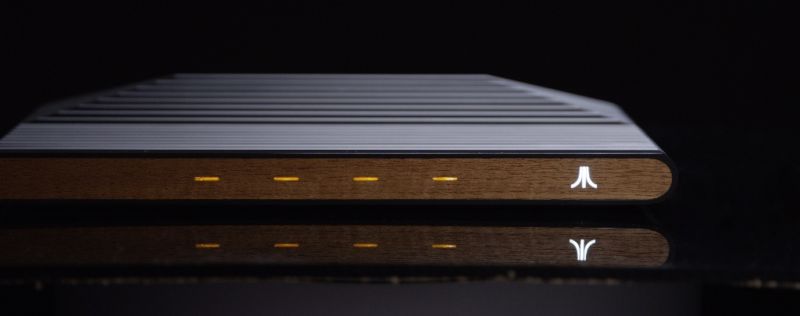
The trademark and license borg that currently calls itself Atari continues to push ahead with an "Ataribox" project, and, after being teased in July, the device has begun to take shape. Fans and press alike may have expected a low-priced, retro-gaming living room device—since they're all the rage and since this thing looks like a tiny, restyled Atari 2600—but Tuesday's news suggests something a little more ambitious.
The spec sheet, as announced, is still pretty vague, but Atari has confirmed a few notable things, starting with a price point between $250 and $300. In exchange for costing roughly as much as a Nintendo Switch, Xbox One S, or PlayStation 4, the Ataribox will come packed with an "AMD customized processor with Radeon graphics technology." Additionally, this will not be an Android system. Instead, the Ataribox will run Linux "with a customized, easy-to-use user interface."
-
Ataribox, wood-paneled prototype.
-
Atari insists that this is made with "real wood."
-
Ataribox, plastic prototype.
-
Top of the case.
As previously announced, the system will include SD card support, an HDMI port, four USB ports, and an Ethernet port; it will launch with at least two aesthetic options: plastic and wood-paneled. The company has yet to show off any additional hardware, particularly retro-styled controllers, that might come with the Ataribox.
Atari has already begun bragging about Ataribox's inherently open nature, advertising that the system will let users customize the OS, enjoy a "full PC experience," and access other digital game and software storefronts. "Most TV devices have closed systems and content stores," Atari's Tuesday announcement says. "Linux lets us be more open."
The system will come preloaded with "tons of classic Atari retro games" (classic and retro!), and it will also be compatible with "current titles from a range of studios." We'll have to wait for more info on both camps of games, along with any sense of whether Atari will deliver those by way of its own digital-download storefront—and whether other devices will be able to access that storefront, as well.
In terms of other storefronts, Atari points out that those digital shops must be compatible with both the OS and the hardware, so it remains to be seen whether the Linux-friendly shop Steam will actually work on an Ataribox. Should that be the case, however, this would essentially be the highest-profile "Steam Machine" launched since that Valve hardware push fizzled out.AMD has not been a major player in the budget-minded "living room box" chipset market. This, however, is a price point it is familiar with—as the supplier of CPU-GPU combo solutions for similarly priced consoles that launched all the way back in 2013. Consumers probably won't be lucking out with Atari purchasing chips on a massive scale, especially as the Ataribox team teases a crowdfunding campaign coming "this fall" on Indiegogo.
Unless Atari has a surprise in terms of its chipset, the company may have a ways to go to convince buyers that its product's mix of open software, custom UI, preloaded Atari games, and Atari 2600-based design is somehow a better combination of value, design, and power than a Raspberry Pi 3 system (if it ever makes it to production, of course). Then again, maybe Atari is just banking on retro-computing fans paying top dollar to snap up this sleek take on the old 2600 design—or, at least, its wood-paneled variant.
reader comments
119